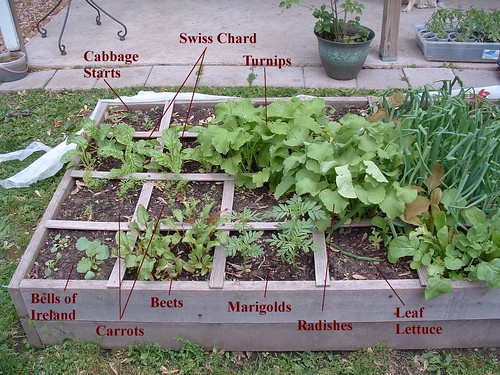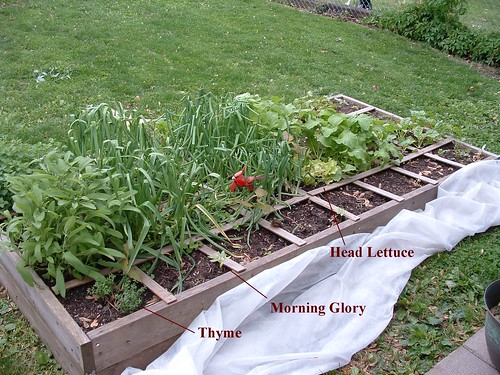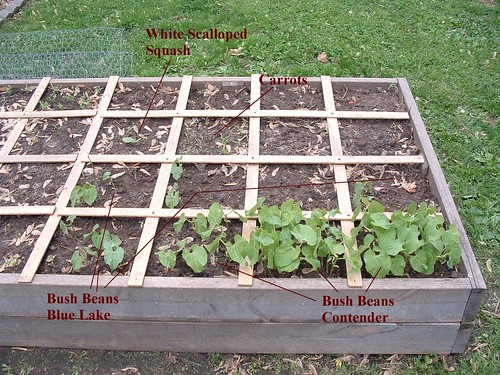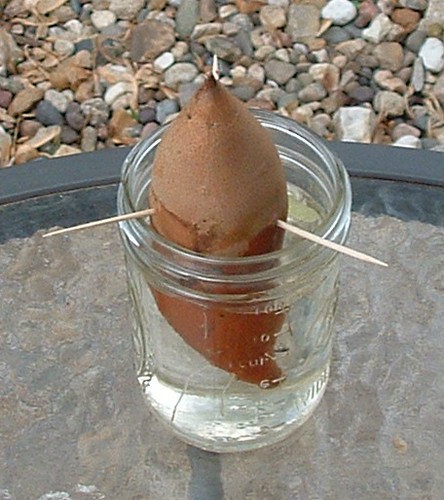Garden Update
It’s been about two weeks, so it’s time for an update. Most things are growing pretty well. I discovered that tacks aren’t enough for holding the floating row cover in place; they tore through in the high winds yesterday. So now I’ve got it wrapped around a 1×2 on each side. That’ll actually be handier anyway, since now it’s not attached to the bed at all, so I can move the whole thing if I want. On to the pictures!
Things have really been growing under the row cover. The radishes are starting to fill out and will probably be ready in a week or so. When I planted those, 16 radishes in a square didn’t seem like many, but now they’re packed.
I forgot to caption the square right above the marigolds, which is celeriac, also known as celery root. Celeriac is a variety of celery that’s grown for the root instead of the stalk. It’s popular in Europe but pretty rare here. Since roots keep longer than plants, I thought it’d be interesting to try. I started those inside and transplanted them, but they’re still so small I forget they’re there. There’s one leaf lettuce square that didn’t come up at all, so I need to replace that and fill in the empty spaces in the carrot squares.
The peas are still recovering from bird damage, but they’re starting to put on some healthy-looking leaves. The mesculine mix lettuce looks great; we could probably start using a few leaves of that anytime. I guess mesculine (or mesclun; there seem to be a few spellings) is a mix of sharper lettuces like arugula and mustard greens. Probably something we should add to milder lettuces in a salad, rather than use by itself.
The sage and oregano already need to be cut way back, and most of the growth so far harvested and dried. Wish we had about a dozen more herbs that looked like that.
This is just a shot of that bed from the other direction, so you can see the thyme and head lettuce hiding behind the taller stuff. I’ve never grown head lettuce successfully; it always gets too hot and bolts early, or too wet and rots. But I figure in raised beds, there’s hope.
This bed was pretty much bare when I took the last pictures. Now the radishes are growing strong (and need thinning), and one yellow squash came up next to them. Fortunately, one squash is all a square will hold (if that). The Geisha Girl flowers are a freebie that came with our seed order, so I don’t know what to expect from them. The peas in the back row were planted later than the other ones, and they’ve been pecked by birds too—despite the roll of chicken wire I set on top of them. The birds actually walk into the wire roll to find their way to the peas. So a floating row cover is going on that bed tonight too. Next year I’ll have to be sure to plant all the peas in the same bed, so at least one doesn’t have to be defended from aerial assault.
My family has grown Blue Lake as our staple green bean for years. We’d always try out a couple other varieties, and grow some purple and yellow ones too, but the Blue Lakes were always the ones we grew the most of because they were such reliable performers. But I think I’m about to switch brands.
Last year we grew Contender for the first time, right next to Blue Lake, and it was outstanding. The two varieties weren’t clearly separated, so I couldn’t say exactly how much better the Contenders did, but a few plants that I knew were Contender bore an amazing number of perfect, straight beans. Now this year you can see how much better the Contender came up compared to the Blue Lake. To be fair, the Blue Lake seed was a year old, so I picked up some new Blue Lake seed today and planted it in the missing spots. We’ll see how it does, and this year we’ll be able to tell exactly which is which. I also planted Blue Lake pole beans in the four farthest squares this morning.
These are the plants we started inside, minus the celeriac which was already transplanted into the garden, plus a couple other tomato varieties that we traded some of our extra Amish Paste for. These were all started in small peat pots, and then transplanted into these plastic cups when they were an inch or two tall. They’ve grown a lot in the past two weeks, especially the tomatoes. All these should be transplanted into the garden this week.
And here’s the sweet potato patch. As you can see, it’s just getting started. The eyes that are underwater are starting to send out roots, which will eventually become the “slips” that you plant in the ground. Those will be going up to the community garden, since they don’t require any day-to-day maintenance.
If you enjoyed this article, why not rate it and share it with your friends on Twitter, Facebook, or StumbleUpon?
loading...







